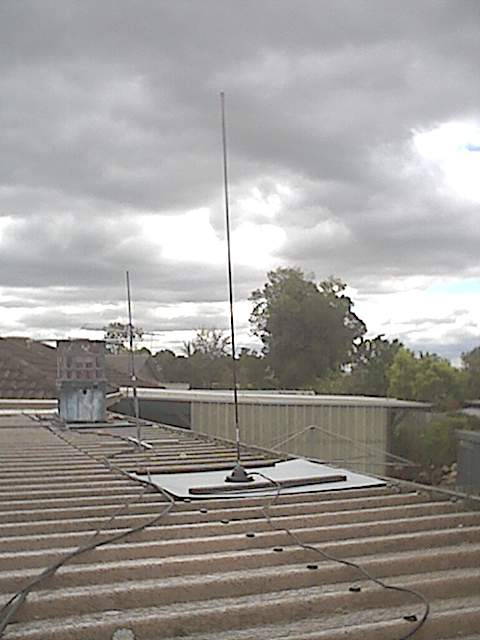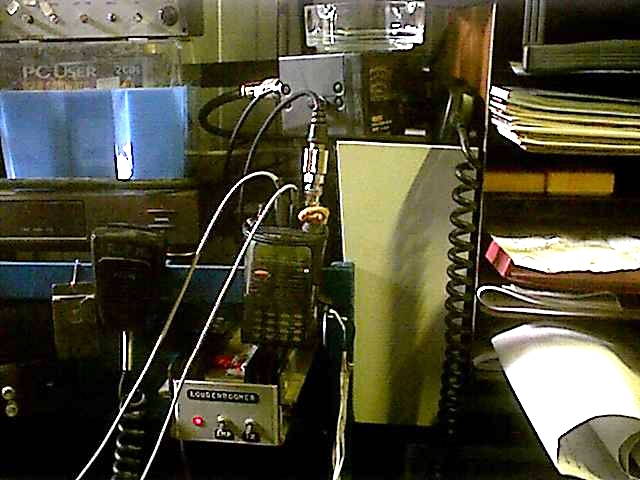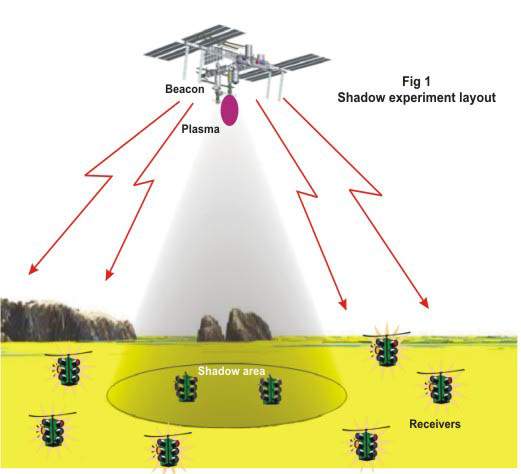ET Shadow Project.
Australian Section.
Science Fiction again becomes reality, Blue Light Engines for Spacecraft.
Project ET Shadow is dedicated to the memory of the crew of
Columbia STS-107.
For those that have gone before us and given their lives so that we may have knowledge.
Space Martyrs.
Phase 2 has begun. Ground testing software. Click here for download page.
If the writing appears small, on the menu above, click view, text size, larger.
If you are not from Australia or nearby, please visit the main ET Shadow Project page at The Central Research Institute for Machine Building, Tsniimash, in Russia.
Click here to go to TSNIIMASH
ET is the abbreviation for the name Electric Thruster. Electric Thruster Ion Propulsion is the next generation of engines for spacecraft. The best way to describe them is by an analogy to the spacecraft in science fiction movies that have blue light engines that make the spacecraft travel very quickly.
We have actually been building these engines since the 1960's and several have been tested in space onboard revolutionary spacecraft such as NASA's DEEP SPACE 1 and the soon to be launched (Sept 27-28 2003) ESA (European Space Agency) SMART-1 probe to the Moon, powered solely by Electric Ion Plasma Engines
The ET Shadow project is open to and available for partcipation by amateur radio operators, short wave listeners, radio scanner enthusiasts and schools around the world. If you have or can obtain or borrow a radio scanner that can receive narrow band FM signals on 145.800 MHz from the International Space Station Alpha and a computer to plug it into, then you can actively participate in the ET Shadow research.
A scanner antenna or aerial will work fine for recieving the Space Stations signals. I have myself made voice contact with the crew on the Space Station (expedition 6) using no more than a 57 inch high 2m mobile antenna made by Mobile One and a 5 watt hand held VHF radio(Alinco DJ-V5) about the size of a packet of cigarettes,( I'm still smiling about that happening : ) ) I have since obtained a small pre-amp and power out booster, homebrew by a VK Melbourne ? amateur lovingly called a loudenboomer??
Images below,
left,
VHF 2m mobile used for spacecraft, on magnetic base stuck to big square of sheetmetal, behind it are a smaller UHF antenna and a crossed dipole or turnstile NOAA weather satellite image antenna sitting on a couple of crates just the right height.
right,
My Alinco DJV5 plugged in with left grey cable to computer, right grey cable from computer, then the antenna. The silver box underneath is the loudenboomer.The black box above right is the power/swr meter.


The computer is required to decode and log the packet radio data from the International Space Station as it passes overhead.
What is Packet Radio you ask? Packet Radio is a system of digital communications used by amateur radio operators for many years. Basically when operating, you can hear noises like modem squawks and then writing comes up on the screen.
What's it all about, why are we doing this ???
When the the ion engine is turned on while pointing down towards the Earth, radio communications is seriously affected and in some cases, blacked out.
This happens in various amounts at different frequencies and this experiment will help map out the extent of the effect.

SOFTWARE YOU WILL NEED
Spacecraft Tracking Software. Displays a mission control type map and locates selected spacecraft.
WinOrbit from Carl Gregory K8CG
or
WxTrack from Mr David Taylor
Because satellites actual positions drift from predicted ones, the tracking software Keps should be updated every 1 to 2 weeks at least for Low Earth Orbit (LEO) spacecraft such as the Space Station. Keps are Keplerian Elements, a text file composed of two lines of numbers for each satellite.
The Satellite Tracking Software reads the keps when it starts.
Keplerian elements from Dr. T.S. Kelso. as text files.
To be able to decode the packet radio from the Space Station you will need to download the following software and install it in your computer.
You must download and install AGW packet engine and its drivers, FIRST,
UISS will not work without AGW running. AGW sends information to the UISS program.
AGW packet engine and drivers from George Rossopoulos SV2AGW
UISS spacecraft communications software from Guy Roels ON6MU (ex ON1DHT)
The UISS software should be registered with ON6MU (ex ON1DHT) to enable all allowable functions, this only costs you an e-mail with a photo of yourself, this is called cardware instead of shareware, it is a type of freeware, but it costs nothing.
If you don't like UISS, try the monitor program that is a part of the SV2AGW Packet Engine collection of software.
The idea of using a program to catch the little packets of info coming from the Space Station is that each one of them will have a time stamp on it.
Your log of time stamps will tell us,
1. when you first heard them. (ISS appears over the horizon coming towards you.)
2. when you first lost contact. (With ISS overhead you will now be in the ET Shadow.)
3. when you regained contact. (With ISS overhead you will now be out of the ET Shadow.)
4. when you lost contact for good. (ISS disappears over the horizon moving away from you.)
A cable coming from the Radio or Scanners extension speaker socket going to the computer sound cards Line In or Mic Input is also required so that the computer software can hear the Space Stations signals.
If you don't have or can't make a cable for the signal, try just putting the computers microphone near the radio or scanners speaker.
The speed of the packet you are listening for is 1200 baud. I shall make a Software Help page and the link is at the bottom of this page.
Click here to download an audio sample of packet radio bursts. pktsamp1.zip 98kb expands into pktsamp1.WAV
so you know what they sound like when trying to find it on a scanner.
Test your equipment and programs out on Earth stations already constantly transmitting. In Australia try listening between 144 MHz and 145 MHz for packet radio signals. 144.900 MHz should have packet traffic on it in most places. 144.900 MHz is relegated for the APRS (Automatic Position Reporting System).
So, all you need is to do is,
1. Have a PC computer available,
2. Obtain a VHF radio or scanner,
3. Make a two wire cable with plugs at each end.(Just a normal shielded extension speaker cable)
4. Install 3 software packages.
5. Download the keps,
Now you should be cooking with gas!
You can monitor all transmissions on this frequency 145.800 MHz of packet and voice.
Not only are the beacon signals from the Space Station to be heard but also conversations between ground based amateur radio operators communicating with each other via the Space Station digipeater, a digipeater is a radio repeater for digital packet radio, it repeats or re-broadcasts the transmission.
I once discovered an entire pass of the Space Station
picked up by a scanner enthusiast in Sydney and placed on the internet newsgroups contained my message to another ground station and his reply, this surprised me a bit as what we were talking about wasn't very interesting, but, I guess the way we were talking was. Quite a pat on the old ego, I tell you.
Loochshee adeen ras oovedeet, chem sto ras ooslishat.
We need to know your location so we can put you on our map. We need your latitude and longtitude or your grid reference, or we can try and work it out.
Click here to e-mail the Shadow team now, if you wish to participate in this experiment in Australia or nearby.
SpEx "Shadow" program supervisor - Valery Borisov, deputy director of TSNIIMASH,
principal investigator - project author Valentin Strashinski (TSNIIMASH).
For more information and details on ion engines, please visit the TSNIIMASH website and explore all the pages.
Click here to go to TSNIIMASH
Click here to go to the Software Installation Help Page.
Click here for a map of participants that have been listed by TSNIIMASH in the Australia ragion.
Click here to visit the ET Shadow site of Mr Thierry Lombry ON4SKY in Belgium.
Click here to visit the International Space Station Fan Club. IFC.
Click here to go to the main page on this, my Amateur Radio site.
Click here to go to my bits and pieces page.
Project ET Shadow is a project involving the International Space Station and YOU.
Visitors to this page since 30/09/2003.
This page was written by Kevin Forbes, amateur radio operator VK3UKF. Last Updated, April 3 2004.


